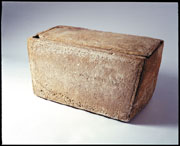
NASHVILLE, Tenn. (BP)–The Israeli antiquities dealer whose discovery of the so-called James ossuary gained worldwide attention has been arrested in Jerusalem allegedly for forging the item.
Oded Golan was arrested July 21 and appeared the next day in court, where police revealed forging equipment — stencils, stones and yet-to-be-completed forgeries — they said were found in his home, according to the Associated Press.
Golan is suspected of forging both the James ossuary and another archeological find, a stone tablet with an inscription from 2 Kings 12 calling for temple repairs. Both items shook the archeological world and had scholars debating their authenticity. The James ossuary contains an inscription on the side reading, “James, son of Joseph, brother of Jesus” — leading scholars to speculate it once contained the remains of the Apostle James. It was valued at $1 to $2 million.
But both finds are now in doubt, although Golan contends they are authentic, according to the AP.
Steven Ortiz, assistant professor of archaeology at New Orleans Baptist Theological Seminary, told Baptist Press that forgery is an “unfortunate problem within the archaeological community” and gives honest archeological scholarship a bad name.
While holding off judgment on the authenticity of the two items, Ortiz said it is “very easy” for a person to forge an item — especially if the person is knowledgeable of the history of the biblical languages.
“There are a lot of scholars, epigraphers, that get duped,” Ortiz said.
Forgery is “more common” when the items have inscriptions — like the two items in question — because scripted items “bring the big money,” he said.
Scholars carefully study the inscription to try and determine if the style of the letters and the words could have been written during an ancient era, Ortiz said. Sometimes, by looking at the inscription under a microscope, it can be easy to spot a forgery, he said.
“You can tell if” the inscription was made by “modern tools or ancient tools,” he said.
But if the item is “weathered,” determining a forgery becomes more difficult, Ortiz said. Weathering is a natural process by which the stone’s characteristics — such as its color — change over time.
“You can tell how long your newspaper has been sitting out in the front yard by how yellow it is,” Ortiz said. “[Similarly,] that happens to the stone.”
Weathering, though, also can be forged, he said.
Even before Golan’s arrest, the Israel Antiquities Authority said in June that both items were fakes. The scholars reached their conclusion about the James ossuary by studying the weathering process. They determined that the patina, a thin film that covers the stone and is acquired with age, had been broken, AP reported.
But in the July/August issue of Biblical Archaeology Review — where the James ossuary was first showcased — scholar Edward J. Keall says that new tests bolster the case for its authenticity. Keall serves as a senior curator at the Toronto Royal Ontario Museum, where the ossuary was displayed last year.
“The studies we conducted have convinced us that the ossuary and its inscription are genuinely ancient and not a modern forgery,” he writes.
Keall argues that the weathering has “occurred at a uniform rate” and that the inscription “has weathered naturally, at the same rate as the adjacent parts of the ossuary.”
–30–
(BP) photo posted in the BP Photo Library at http://www.bpnews.net. Photo title: IN QUESTION.

















